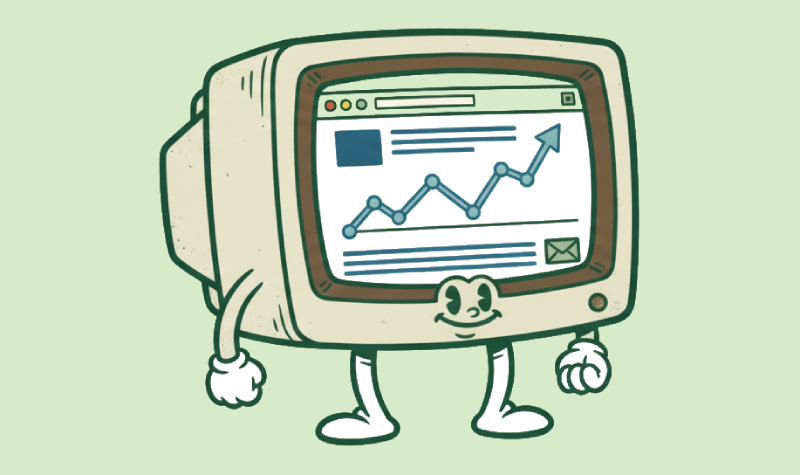.
Six Signs That You May Need a New Website
The way businesses use their websites has evolved rapidly, and what once served as a simple point of reference has become a defining part of how people perceive, evaluate and choose who to buy from. In many cases, that shift has happened faster than business owners, marketing leads and internal teams realise. A website that once felt fresh and functional can quietly fall behind as design standards move on, technology advances and user expectations continue to rise.
Today, a website is expected to do far more than display information. It needs to perform seamlessly across devices, communicate credibility through design and structure, and support every stage of the customer journey from discovery to conversion. When it fails to meet those expectations, the effects ripple across search performance, paid media and overall brand perception, making every other marketing effort work harder to achieve the same result.
At boxChilli, we see this pattern regularly when clients come to us. Businesses evolve, services expand and marketing strategies become more sophisticated, but the website remains tied to an earlier version of the organisation. The gap between what the business has become and what its website communicates widens slowly, creating subtle barriers that limit growth. This article looks at six signs that your website may be holding you back, and how identifying them early can help you recover performance, reinforce trust and build a stronger foundation for the next stage of growth within your wider business.
The Everyday Frustrations That Signal Something Isn’t Working
Long before analytics start to show a decline in performance, most teams already sense that something about their website is holding them back.
Marketing leads notice that campaign results are no longer improving at the same pace, even though effort and investment remain consistent. Sales teams find that enquiries take longer to arrive or that once-warm leads have started to lose momentum. Internally, updating pages or publishing new content becomes more difficult than it should be, with small technical barriers slowing down day-to-day marketing activity.
In many cases, these frustrations stem from a single underlying issue… the website no longer reflects the organisation as it exists today.
It may have been designed when the brand was smaller, before a rebrand or without the data that now shapes modern user journeys. Over time, those small misalignments accumulate. Calls to action no longer match current messaging, navigation feels less intuitive and performance begins to lag behind what users expect from a professional, contemporary site.
When this happens, the issue rarely sits with marketing execution itself but with the digital infrastructure supporting it. Campaigns, ads, and organic content are all funnelled through a platform that isn’t optimised for the business it represents. Recognising this early gives teams the opportunity to plan strategically rather than reactively – to make data-led improvements that restore performance and allow marketing activity to work at full potential once again.

1. The Design No Longer Reflects the Business
A website should evolve at the same pace as the business behind it. As products expand, audiences shift and brand identity matures, design needs to adapt to communicate those changes clearly. When it doesn’t, the gap becomes visible with not only in how the site looks, but in how it feels to use. What once appeared modern and aligned with your business can start to look dated, particularly when compared with updated marketing materials, new campaigns or a more confident tone of voice.
First Impressions and Credibility
Design plays a defining role in how people judge a brand’s credibility. Visitors quickly form opinions based on subtle cues like colour, layout and typography, often before they’ve read a single word. If your site feels visually inconsistent, cluttered, or simply behind current expectations, it can influence how trustworthy or established your business appears. These signals may be unspoken, but they shape perception in ways that directly affect enquiry rates and engagement.
Modern Design Is About More Than Looks
A strong design system is about much more than how a website looks, it defines how people experience it. When content is organised logically and navigation feels intuitive, users can move through pages effortlessly and focus on what matters most. Responsive layouts ensure that experience remains consistent across every device, while accessibility standards make it inclusive for all visitors. When these elements come together, design stops being a surface-level concern and becomes part of how your brand communicates clarity, professionalism and trust.
When to Reassess Your Design
It’s usually time to review your website if:
- It feels disconnected from your current branding or marketing materials
- Competitor sites look more up to date or easier to use
- Navigation takes too much effort, or calls to action don’t stand out
- Imagery, colours, or fonts feel inconsistent from page to page
In many cases, a redesign isn’t about changing everything, it can simply be about bringing your website back in line with how your business looks, sounds and operates today. When design, content and usability work together again, your site naturally feels more trustworthy and relevant.
2. The Website Is Difficult to Manage or Update
A good website should evolve as quickly as the business behind it. When making a small content change requires developer input or every update feels risky, it’s often a sign that your site is built on an inflexible or outdated system. Over time, these limitations can slow down campaigns, create internal bottlenecks, and prevent your marketing team from acting on new opportunities.
Why Flexibility Matters
Modern content management systems such as WordPress are designed to give teams more control. They allow you to update imagery, publish new pages and adjust layouts without technical friction. When that flexibility isn’t there, every change becomes a compromise. A campaign might be delayed, content might go live out of sync with other channels, and small inconsistencies start to appear across the site. The ability to edit confidently and independently keeps content fresh, accurate and aligned with what your audience expects.
The Impact on Growth
A website that’s hard to maintain doesn’t just create frustration internally, it can quietly reduce visibility and long-term performance. Outdated plugins or neglected software can cause technical issues that affect SEO, while slow or buggy content updates make it harder to keep pace with changing products or services. Over time, these issues add up, affecting everything from load speed and security to the trust users place in your brand.
When to Reassess Your Platform
It may be time to review your website’s platform or setup if:
- Routine updates require a developer or result in layout issues
- Plugins or integrations regularly conflict after updates
- Publishing new content takes longer than it should
- Security warnings or compatibility problems keep appearing
Moving to a more modern and flexible platform allows your team to manage updates quickly, keep content accurate, and reduce technical risk. It also creates a stronger foundation for growth, giving you the freedom to make improvements, launch campaigns, and keep the site running smoothly without unnecessary dependency or delay.
3. The User Experience Feels Outdated or Inconsistent
A website should feel effortless to use, guiding visitors naturally through information without confusion or unnecessary clicks. When layouts become cluttered, navigation feels disjointed, or calls to action aren’t immediately clear, the overall experience begins to feel dated. These small usability issues might not be obvious at first, but as they accumulate, they start to slow down engagement and make the site less effective at generating enquiries or sales.
The Connection Between Usability and Trust
The easier a website is to use, the more confident people feel about the business behind it. Visitors make quick judgments based on clarity and structure – for example, if pages are well organised, menus make sense, and buttons behave predictably, they’re more likely to engage and convert. When that experience breaks down through cluttered layouts, confusing navigation, or inconsistent styling, it creates hesitation that directly affects conversions and credibility.
What It Means for Performance
A well-structured user journey directly supports performance across every metric. When people can move through a site easily, they spend longer engaging with content and are far more likely to complete an enquiry or purchase. Search engines also recognise these patterns of interaction, which means a clear, consistent experience can contribute to better visibility and organic growth over time.
When to Review the User Journey
It may be time to reassess your website’s user experience if:
- Key pages take too many clicks to reach
- Layouts feel cluttered or difficult to follow
- Buttons, links, or forms behave differently across devices
- Calls to action are hard to spot or don’t stand out visually
Refining the user experience doesn’t always require a complete rebuild. Small, focused changes to layout, navigation, and visual hierarchy can make a big difference, helping visitors move through your site confidently while improving conversion rates and overall satisfaction.
4. The Website Isn’t Delivering Consistent Results
When a website begins to produce fewer enquiries, sales, or conversions, it often reflects a gradual disconnect between the site and the needs of its audience. Over time, design, structure, and messaging can drift out of sync with how people search, compare, and make decisions online. The change can be subtle at first, but as expectations evolve, the impact becomes clearer in analytics and across wider marketing performance.
Understanding the Shift
A decline in results rarely comes down to a single cause. Sometimes the layout no longer supports how users navigate, or key pages fail to communicate value clearly. In other cases, calls to action might be positioned awkwardly, or tracking tools may not capture the right data. Technical factors such as slow loading speeds or outdated integrations can also play a part, quietly reducing both visibility and trust. When several of these issues overlap, the combined effect can make the site feel less persuasive and harder to measure accurately.
Using Data to Identify Patterns
Analytics can reveal where performance is being lost, but numbers alone rarely tell the full story. Reviewing conversion rate optimisation techniques like heatmaps, user recordings and journey paths helps to identify the exact moments where visitors lose interest or fail to complete an action. Comparing these insights with business priorities such as key service areas or campaign objectives, highlights where the experience needs to be refined. This process is not only about fixing what’s broken, but about ensuring the website still supports how your audience actually engages today.
When to Reassess Your Conversion Strategy
It may be time to review your approach if:
- Conversions have dropped despite steady or growing traffic
- Leads or sales fluctuate without a clear pattern
- Tracking data feels incomplete or unreliable
- Visitors browse but rarely take the next step
Revisiting your conversion process should start with clarity – understanding where users hesitate, what information they need at each stage and how effectively your website guides them through that decision. Often the solution lies in improving the structure of key pages, clarifying messaging, or removing unnecessary steps that slow the journey down. When those barriers are reduced, results become more consistent, and your website begins to support growth rather than restrict it.
5. The Website Isn’t Performing Technically
Even a well-designed website will struggle to perform if the technical foundation is outdated or poorly maintained. Slow loading speeds, broken links, and software issues often develop gradually, but they have a direct impact on how users experience the site and how search engines evaluate it. Over time, these technical weaknesses reduce visibility, increase bounce rates and make it harder for your marketing activity to deliver results.
The Role of Technical Health
A technically sound website feels effortless to use. Pages load quickly, navigation responds smoothly, and features work consistently across devices, allowing users to focus on what they came for rather than waiting or troubleshooting. The same factors that improve user experience also strengthen visibility, as search engines favour websites that are stable, secure, and easy to crawl. A strong technical foundation therefore supports every other aspect of performance, helping your website maintain reliability and trust over time.
How Technical Gaps Affect Results
When a website’s performance declines, the effects often reach further than expected. A few slow pages can increase bounce rates and reduce engagement, while a single outdated plugin can create errors that distort analytics or interfere with lead tracking. Issues like this don’t just disrupt the experience for visitors, they make it harder for your team to manage campaigns and measure what’s working effectively. Keeping the technical setup well maintained ensures the site remains responsive, accurate, and capable of supporting new initiatives without risk or delay.
When to Reassess Technical Performance
It’s worth reviewing your technical setup if:
- Pages take noticeably longer to load or fail Core Web Vitals tests
- Forms, menus, or integrations behave unpredictably
- Layouts break or display incorrectly after updates
- Security alerts or plugin conflicts appear regularly
Routine technical checks prevent small issues from becoming barriers to growth. Keeping the site fast, secure, and consistent provides users with a reliable experience and gives your business the confidence that every interaction, campaign, and conversion is being supported by a stable platform.
6. The Website No Longer Supports Your Growth
As a business grows, the demands placed on its website naturally increase. What once worked well for a small product range or a single location can start to feel limiting as new services, audiences, and marketing channels develop. A website that isn’t built to scale can quickly become a constraint by holding back campaigns, restricting functionality and creating extra work for teams trying to keep up with change.
Recognising the Signs of Outgrown Infrastructure
When a website starts to reach its limits, the symptoms are usually practical. Adding new pages may slow the system down or break existing layouts, integrations with other tools might fail to connect properly, and tracking can become unreliable as data flows through outdated setups. These issues make it harder to run campaigns smoothly and to measure their results accurately. Over time, the site begins to feel reactive rather than strategic, forcing the business to adapt to its limitations instead of the other way around.
Why Scalability Matters
A scalable website is designed to grow alongside the business it represents. It supports new functionality, connects easily with emerging tools and allows marketing teams to test ideas without risk or delay. As technology evolves and customer expectations shift, having the flexibility to expand without rebuilding every few years becomes essential. When your website can adapt in step with your organisation, it remains a long-term asset rather than a recurring project.
When to Reassess for Scalability
It’s worth reviewing whether your website can support future growth if:
- Expanding the site structure or adding features regularly causes problems
- Third-party tools, APIs, or CRMs are difficult to integrate
- Content management feels restricted or slow when scaling new areas
- Campaigns require complex workarounds to track or automate effectively
Planning ahead ensures your website continues to perform as your business evolves. Investing in a scalable, well-structured platform gives teams the freedom to develop new campaigns, explore new markets, and maintain a consistent experience for users as demand grows – keeping your digital presence aligned with where the business is heading, not where it used to be.
The boxChilli Perspective
Over the years, we’ve worked with many businesses that reached a point where their website no longer matched who they had become. Teams had invested in new marketing channels, refined their brand and built stronger operations, yet the website still reflected an earlier stage of their journey. The result was familiar with all of the above… slow updates, underperforming campaigns and a digital presence that didn’t communicate the quality or credibility of the business behind it.
What tends to make the biggest difference isn’t a complete rebuild, but a clear, structured review of what the site needs to do next. By focusing on user experience, performance and scalability, it becomes possible to bring everything back into alignment and create a website that supports rather than restricts progress.
At boxChilli, our role is to guide that process with the right blend of strategy, creativity and technical understanding. Whether that means refining structure, updating visual identity, or rebuilding from the ground up, the goal is always the same – to help businesses maintain momentum, communicate clearly and use their website as a reliable foundation for future growth.
Key Takeaways
- A website should evolve alongside the business… Growth naturally changes how a company looks, sounds, and operates – the website should reflect that evolution.
- User experience is a measure of trust… When navigation is clear and design feels intuitive, people engage more and stay longer.
- Flexibility supports performance… Teams work faster and with more confidence when content updates are straightforward and reliable.
- Technical health influences visibility… Fast, secure, and accessible websites perform better in search and create a stronger impression across every touchpoint.
- Modernisation doesn’t have to be disruptive… Incremental updates and focused improvements can often restore performance without the need for a full rebuild.
- Growth depends on alignment… When design, content, and functionality work together, the website becomes an active part of how a business grows.





